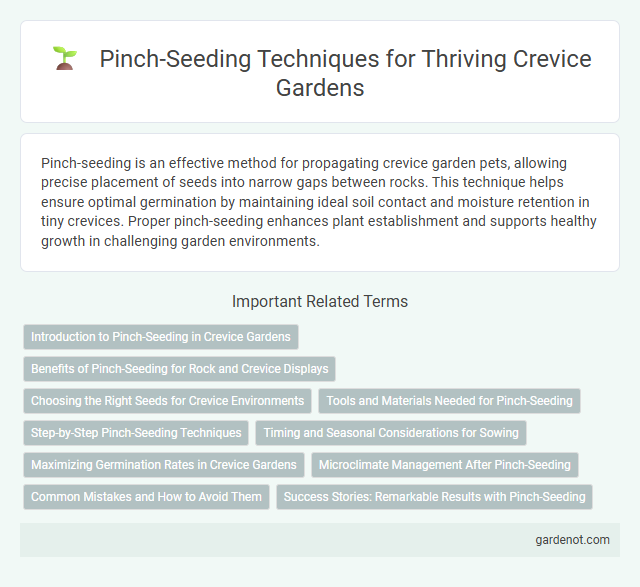Pinch-seeding is an effective method for propagating crevice garden pets, allowing precise placement of seeds into narrow gaps between rocks. This technique helps ensure optimal germination by maintaining ideal soil contact and moisture retention in tiny crevices. Proper pinch-seeding enhances plant establishment and supports healthy growth in challenging garden environments.
Introduction to Pinch-Seeding in Crevice Gardens
Pinch-seeding in crevice gardens involves sowing tiny seeds directly into narrow soil gaps between rocks, promoting natural growth in minimal soil conditions. This method enhances seed establishment by mimicking the native environment where microclimates and moisture retention favor delicate seedlings. Applying pinch-seeding supports biodiversity and plant diversity by enabling precise placement of alpine or rock garden species in crevice landscapes.
Benefits of Pinch-Seeding for Rock and Crevice Displays
Pinch-seeding enhances rock and crevice garden displays by promoting natural seed dispersal and uniform plant establishment in narrow spaces. This technique improves root development and reduces transplant shock, leading to healthier, more resilient plants suited to harsh, rocky environments. Pinch-seeding also supports biodiversity by encouraging the growth of native species adapted to crevice microclimates.
Choosing the Right Seeds for Crevice Environments
Selecting seeds for a crevice garden demands plants with strong drought tolerance, shallow root systems, and adaptability to minimal soil. Succulents, alpine species, and native wildflowers thrive in these microhabitats, providing resilience and prolonged bloom periods. Opt for seeds known for quick germination and compact growth to maximize success in narrow, rocky crevices.
Tools and Materials Needed for Pinch-Seeding
Pinch-seeding requires essential tools such as fine seed trays or shallow containers, a small hand rake or dibber for creating shallow indentations, and a misting spray bottle to ensure delicate seeds remain moist without being displaced. Quality seed-starting mix or finely sifted soil provides an ideal medium for germination, promoting optimal moisture retention and aeration. Using tweezers or a seed-picker can enhance precision when handling tiny seeds, ensuring accurate placement and preventing overcrowding in a crevice garden.
Step-by-Step Pinch-Seeding Techniques
Pinch-seeding in a crevice garden involves carefully placing seeds into small cracks or crevices within rocks, ensuring optimal soil contact for germination. Begin by prepping the soil within the crevice to be moist but well-drained, then gently press seeds into the crevice surface without burying them deep. Maintain consistent moisture and protect the area from harsh sunlight or heavy rain to encourage successful sprouting and growth.
Timing and Seasonal Considerations for Sowing
Pinch-seeding in crevice gardens requires precise timing to match the microclimate and seasonal shifts, typically early spring or late summer for optimal germination. Avoid sowing during extreme heat or frost periods to ensure seedling survival and robust growth. Monitoring soil temperature and moisture levels in narrow crevices improves seedling establishment and long-term garden success.
Maximizing Germination Rates in Crevice Gardens
Pinch-seeding in crevice gardens involves placing individual seeds precisely into soil pockets to enhance germination rates by minimizing seed competition and ensuring optimal moisture contact. Maintaining consistent microclimate conditions, such as balanced moisture and temperature within the narrow crevices, significantly boosts seedling emergence. Utilizing fine, well-draining soil mixtures tailored for crevice environments promotes root development and maximizes overall germination success.
Microclimate Management After Pinch-Seeding
Microclimate management after pinch-seeding in a crevice garden involves maintaining consistent moisture levels and temperature to ensure optimal seed germination and seedling establishment. Using shade cloths or strategically placed rocks can help moderate temperature fluctuations and protect emerging seedlings from harsh sunlight or wind. Regular monitoring and gentle watering prevent soil desiccation while avoiding waterlogging, promoting robust root development in the unique microhabitats of crevice gardens.
Common Mistakes and How to Avoid Them
Pinch-seeding in crevice gardens often faces common mistakes such as overseeding, which leads to overcrowding and weak plant growth, and planting seeds too deeply, causing poor germination rates. To avoid these issues, use only a small amount of seed per crevice and place seeds just beneath the soil surface for optimal moisture access. Ensuring proper spacing and shallow sowing improves seedling development and enhances the aesthetic appeal of the crevice garden.
Success Stories: Remarkable Results with Pinch-Seeding
Pinch-seeding in crevice gardens has yielded remarkable success by promoting robust plant establishment and thriving micro-ecosystems within narrow stone gaps. Gardeners report accelerated germination rates and healthier root systems, especially with alpine and drought-tolerant species adapted to crevice garden conditions. This method enhances plant diversity and resilience, contributing to visually stunning and ecologically sustainable rock garden displays.
Pinch-seeding Infographic

 gardenot.com
gardenot.com